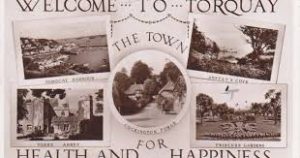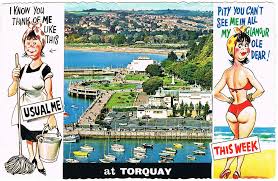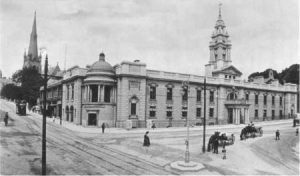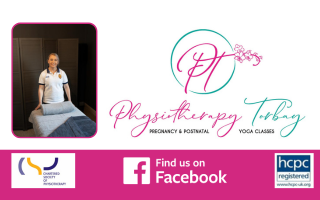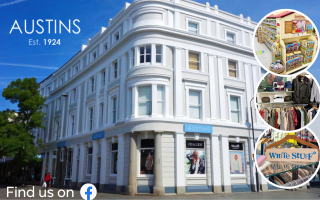Is having an interest in the history of our Torbay just a bit of fun?
Local history is certainly enjoyable – but it is also crucial in understanding who we are, how we got here, and where we’re going.
Not all towns across Britain are the same – some are very different and it’s these differences that have their roots in history and geography. Indeed, you can only really get an understanding of where our three towns are going if you know where we are now and where we came from.
To take one example. History drives our culture and leads into our politics. Exeter is only 23 miles away, has a smaller population that Torbay, but is a very different and wealthier place. This is reflected in politics – in the Brexit referendum Torbay voted 63.2% to Leave, while Exeter 55% to Remain.
Here are the current facts – which are always immediately out of date. Around 133,883 people live in Torbay. There are, on average, 3.8 births per day and 4.8 deaths per day. On the face of it this should mean that the Bay’s population is falling rapidly. Of course, it isn’t, as we have high numbers of people coming to live here – hence the building on the outskirts of Torquay and Paignton.
And who are these incomers? With our origins as a health resort, we’ve always attracted the retired, and those welcome and often wealthy incomers now make up a large proportion of our ageing population.
The average age in Torbay is 44.8 years – it’s 40 years in the rest of the UK. Significantly, 3.7% of the local population are now aged 85 years and over. This number of over 85s is expected to increase by around 3,000 (56%) over the next decade or so, and we know that more of us are going to be frail and require support from health and social care services- there’s already over 90 care homes in the Bay, the second highest in the country.
But this is something that should be celebrated. From the 1500s until around 1800, life expectancy hovered between 30 and 40 years of age. A local newborn boy was expected to live to 40.2 in 1841, whereas a baby girl was expected to live to 42.2. Today, in Brixham, Paignton and Torquay life expectancy at birth is 83.3 years for women and 78.9 years for men. But note that age gap. There’s a real danger of loneliness and isolation for the elderly with many women living alone having moved away from friends and family. And those age-related illnesses are increasing because we’re around long enough to acquire them!
Alongside those retiring, other incomers are here for a variety of reasons- to start a new life, or to escape from something. Notably, seaside towns have always attracted those whose relationship has broken down and who want a new start – Britain’s highest proportions of divorcees live in Blackpool, Hastings, Eastbourne and, of course, Torbay.
Family breakdown impacts the most vulnerable – 285 children were being looked after by our Local Authority in 2017. Each a cause for sadness, but also extremely expensive – the number of looked after children remains amongst the highest in England.
Tourist resorts are also party towns – and this may have caused an anti-intellectual tradition in the Bay. There may further be an expectation of hedonism linked to our unhealthy lifestyles: around 6 out of 10 adults in Torbay are overweight or obese (that’s 66,400 of us); around 1 in 6 adults in Torbay smoke (around 18,100); there are high levels of alcohol related admissions to hospital; and we have high levels of self-harm and suicide.
Taking on the consequences of much of this ill health and social problems are our 6 public sector organisations – on an average day, they spend around £2.5 million.
We also need to look back to see why we now have the second highest level of multiple deprivation, and are ranked within the top 20% most deprived local authorities in England. As a bit of a comparison: Torbay has 28.8 on the Deprivation Score; compared to Blackpool (42.0); Redcar & Cleveland (28.6); Sefton (25.7); Wirral (26.9); and Cornwall (23.8).
Inequalities have been widening as relative deprivation worsens – Torbay is ranked as the most deprived local authority in the South West region with around 1 in 4 children living in households are in poverty- in primary schools, one in five children is obese by the time they reach Year 6.
And housing is polarising. This is again a legacy of Torbay’s past and the time when Torquay was the richest town in England. We were left with a plethora of large Victorian and Edwardian houses. Those with sea and country views were replaced or converted into luxury apartments, while some without views became our Houses in Multiple Occupation. Due to a long-term lack of investment in social housing there are also higher proportions of the population living in the private rented sector and lower levels living in social housing in Torbay. Housing conditions are consequently worse in Torbay than the average, with 45% living in the bottom 20% in England for indoor deprivation.
We’ve never been places to actually make things. In Paignton and Brixham in particular we’ve relied on tourism and part-time, seasonal work after a decision was taken in the mid nineteenth century not to become industrial towns. Hence, Torbay’s economy is amongst the weakest in England.
This all matters. The gap in life expectancy at birth between communities across Torbay is around 8.9 years for males and 5.2 years for females. If we include lost taxes, higher welfare payments and higher NHS healthcare costs this represents a cost of inequality in illness of around £75 to £80 million per year in the Bay.
We began by saying that local history is crucial in understanding who we are, and how we got here. It can also tell us where we might be going, and whether we want to change direction…

You can join us on our social media pages, follow us on Facebook or Twitter and keep up to date with whats going on in South Devon.
Got a news story, blog or press release that you’d like to share or want to advertise with us? Contact us




